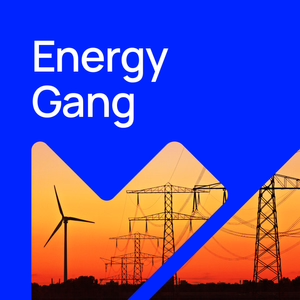
Fifty years since the first Oil Shock: how much has changed?
10/20/23 • 62 min
1 Listener
This week marks 50 years, almost to the day, since the 1973 OPEC oil embargo on the US, which led to global oil prices soaring. Oil’s potential role as a political weapon was thrown into sharp relief, and the world woke up to a new awareness of the vital importance of energy security.
On the Energy Gang this week, Ed Crooks hosts Robbie Orvis and Amy Myers Jaffe, to explore the parallels between that first great oil shock and the economic and political issues arising from the conflict in the Middle East today. Robbie is Senior Director of Modeling and Analysis at the think-tank Energy Innovation, and Amy is Director of NYU’s Energy, Climate Justice and Sustainability Lab. Together they discuss the implications for energy security in the US, and around the world, of the fighting that began with the Hamas terrorist attack on Israel.
This month US oil production has hit a new all-time record high, at 13.2 million barrels a day. This surge in production means the US will be a net exporter of crude and oil products this year, to the tune of almost 2 million barrels a day. That sounds like it should help US energy security, but does it really? Despite surging production, US consumers remain vulnerable to fluctuations in fuel prices. Reducing oil consumption, as the gang discuss, could be the best way to strengthen energy security.
Electric vehicles play a critical role in helping to break our addiction to oil. There have been some big changes in that industry this year, with most leading auto-makers, including Hyundai, Kia, Ford, GM, and others, adopting the North American Charging Standard developed by Tesla. That is a big win for Elon Musk, but more importantly it’s a big win for customers, who won’t have to worry about getting an EV with the right connection ports to find public chargers. It’s like Lightning cables versus USB-C, but with much more at stake.
Finally, we look once again at the ever-evolving hydrogen sector. The Biden administration last week announced the seven Hydrogen Hubs selected to share $7 billion in government funding to accelerate the domestic market for clean hydrogen. The hubs are spread around the country, from the Pacific Northwest to south Texas, and are intended to catalyse more than $40 billion of private sector investment.
The idea behind the hubs is that developing the industry in a few locations will make it easier to share infrastructure and a skilled workforce, helping to bring costs down faster. But questions still remain about how big a role hydrogen can play in the energy transition.
It’s a packed show, and as usual we are keen to hear thoughts and comments. You can find us on most platforms – we’re @theenergygang. Subscribe to the show so you don’t miss the next one, out every second Friday at 7am ET.
See Privacy Policy at https://art19.com/privacy and California Privacy Notice at https://art19.com/privacy#do-not-sell-my-info.
This week marks 50 years, almost to the day, since the 1973 OPEC oil embargo on the US, which led to global oil prices soaring. Oil’s potential role as a political weapon was thrown into sharp relief, and the world woke up to a new awareness of the vital importance of energy security.
On the Energy Gang this week, Ed Crooks hosts Robbie Orvis and Amy Myers Jaffe, to explore the parallels between that first great oil shock and the economic and political issues arising from the conflict in the Middle East today. Robbie is Senior Director of Modeling and Analysis at the think-tank Energy Innovation, and Amy is Director of NYU’s Energy, Climate Justice and Sustainability Lab. Together they discuss the implications for energy security in the US, and around the world, of the fighting that began with the Hamas terrorist attack on Israel.
This month US oil production has hit a new all-time record high, at 13.2 million barrels a day. This surge in production means the US will be a net exporter of crude and oil products this year, to the tune of almost 2 million barrels a day. That sounds like it should help US energy security, but does it really? Despite surging production, US consumers remain vulnerable to fluctuations in fuel prices. Reducing oil consumption, as the gang discuss, could be the best way to strengthen energy security.
Electric vehicles play a critical role in helping to break our addiction to oil. There have been some big changes in that industry this year, with most leading auto-makers, including Hyundai, Kia, Ford, GM, and others, adopting the North American Charging Standard developed by Tesla. That is a big win for Elon Musk, but more importantly it’s a big win for customers, who won’t have to worry about getting an EV with the right connection ports to find public chargers. It’s like Lightning cables versus USB-C, but with much more at stake.
Finally, we look once again at the ever-evolving hydrogen sector. The Biden administration last week announced the seven Hydrogen Hubs selected to share $7 billion in government funding to accelerate the domestic market for clean hydrogen. The hubs are spread around the country, from the Pacific Northwest to south Texas, and are intended to catalyse more than $40 billion of private sector investment.
The idea behind the hubs is that developing the industry in a few locations will make it easier to share infrastructure and a skilled workforce, helping to bring costs down faster. But questions still remain about how big a role hydrogen can play in the energy transition.
It’s a packed show, and as usual we are keen to hear thoughts and comments. You can find us on most platforms – we’re @theenergygang. Subscribe to the show so you don’t miss the next one, out every second Friday at 7am ET.
See Privacy Policy at https://art19.com/privacy and California Privacy Notice at https://art19.com/privacy#do-not-sell-my-info.
Previous Episode

The energy transition needs minerals. Is deep sea mining the best way to get them?
The International Energy Agency last month held its first ever summit to discuss Critical Minerals and Clean Energy. It was attended by more than 50 countries, which came together to discuss ways to secure the critical minerals that are needed to make the transition to low-carbon energy.
Whether it’s copper wiring in electricity systems, steel in a wind turbine, or lithium in an EV battery, metals are vital for low-carbon technologies, and demand is only going to increase over the next decade. New mines for these metals can take a long time to bring into production, raising fears about whether supplies can keep up. One solution to this problem that’s been getting a lot of attention recently is sea-bed mining.
It is a potentially significant new source of supply for some of these critical metals, but it’s also highly controversial because of the damage it could do to deep water ocean ecosystems.
On the Energy Gang this week, Ed Crooks is back in the host’s chair, and joined by regular Amy Harder, Executive Editor of Cipher, a news outlet supported by Breakthrough Energy.
Amy recently interviewed the Prime Minister of Norway, Jonas Gahr Støre, in New York, and she details the main takeaways from that conversation on the show today. Some Norwegian lawmakers have called for a 10-year delay to the country’s plans to allow deep sea mining so that the environmental impacts can be studied.
Dr Melissa Lott, Director of Columbia University’s Center on Global Energy Policy, is also on the show and she outlines some of those environmental impacts.
The demand for critical minerals could necessitate offshore mining, but it is not the only possible option.
Recycling can be another source of increased supply. A study from the International Council on Clean Transportation said that at the end of last year, US plants had the capacity to produce about 100,000 tons a year of recycled battery materials. Total capacity for proposed new plants that have been announced is about 650,000 tons a year.
Even that is still only enough for about 1.3 million EVs a year, which might be roughly the number that will be sold in the US this year. So as the market grows, we are going to need more.
Plus, the IEA published a report last week called the ‘Net Zero Roadmap’, which said the road was still open to limit warming to 1.5 degrees Celsius. But is it really feasible? Is it time to call it, admit that that goal is out of reach, and concentrate on a more achievable target? Could carbon capture now be our only hope of reaching that goal?
Subscribe to the show so you don’t miss an episode, out every second Friday, and follow the conversation on X – we’re @theenergygang.
See Privacy Policy at https://art19.com/privacy and California Privacy Notice at https://art19.com/privacy#do-not-sell-my-info.
Next Episode

Will oil, gas and coal peak by 2030?
The International Energy Agency last week published its World Energy Outlook, which is its big annual review of everything that is going on in the world of energy.
One of the headlines that has been attracting a lot of attention is the forecast that, on current trends, demand for all three fossil fuels – that is, oil, gas and goal – will peak before 2030. The IEA’s report states that the pathway to limiting global warming to 1.5 degrees C, the objective the world set in the Paris Agreement, is still open. Although if we carry on as we are, by 2030 it won’t be.
Joining Ed Crooks to discuss the IEA’s views and progress in the transition away from fossil fuels are Dr Melissa Lott and Amy Myers-Jaffe. Regular Energy Gang guests, Melissa is Director of Columbia University’s Center on Global Energy Policy. Amy heads up NYU’s Energy, Climate Justice and Sustainability Lab.
They debate whether this decade might witness the arrival of peak fossil fuel demand. What are the forecasts saying, and are they believable? The gang weigh up the recent tide of bad news about electric vehicles. Should we be preparing for an abrupt turn away from EVs? What could it mean for oil demand if it happened? And how should we interpret the two recent mega-deals in the US oil industry?
Plus: offshore wind is in trouble. Rising interest rates and supply chain issues are driving up costs, and big projects in the US are being cancelled. Can the industry find a way out of its predicament?
And finally, China’s share of global production of spherical graphite, used in battery anodes, is over 99%, putting it in a strong position in global supply chains. Now China has announced new export restrictions on several forms of graphite, raising questions about whether a new vulnerability has been exposed for US and European battery and EV manufacturers.
It’s a packed show, and as always we are keen to hear your thoughts and comments. You can find us on most platforms as @theenergygang. Subscribe to the show so you don’t miss the next one, out every second Friday at 7am ET.
See Privacy Policy at https://art19.com/privacy and California Privacy Notice at https://art19.com/privacy#do-not-sell-my-info.
If you like this episode you’ll love
Episode Comments
Generate a badge
Get a badge for your website that links back to this episode
<a href="https://goodpods.com/podcasts/energy-gang-35628/fifty-years-since-the-first-oil-shock-how-much-has-changed-35194511"> <img src="https://storage.googleapis.com/goodpods-images-bucket/badges/generic-badge-1.svg" alt="listen to fifty years since the first oil shock: how much has changed? on goodpods" style="width: 225px" /> </a>
Copy




